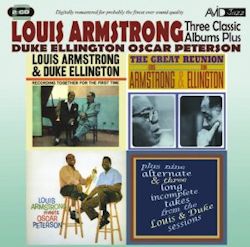CD1
Louis Armstrong & Duke Ellington: Recording Together For The First Time
1. Duke’s Place
2. I’m Just A Lucky So And So
3. Cottontail
4. Mood Indigo
5. Do Nothin’ Till You Hear From Me
6. The Beautiful American
7. Black And Tan Fantasy
8. Drop Me Off In Harlem
9. The Mooche
10. In A Mellow Tone
The Great Reunion: Louis Armstrong & Duke Ellington
11. It Don’t Mean A Thing (If It Ain’t Got That Swing)
12. Solitude
13. Don’t Get Around Much Anymore
14. I’m Beginning To See The Light
15. Just Squeeze Me
16. I Got It Bad (And That Ain’t Good)
17. Azalea
Out-Takes
18. In A Mellow Tone
19. I’m Beginning To See The Light
20. Don’t Get Around Much Anymore
Louis Armstrong – Trumpet, vocals
Duke Ellington – Piano
Trummy Young – Trombone
Barney Bigard – Clarinet
Mort Herbert – Bass
Danny Barcelona - Drums
CD2
Louis Armstrong Meets Oscar Peterson
1. That Old Feeling
2. Let’s Fall In Love
3. I’ll Never Be The Same
4. Blues In The Night
5. How Long Has This Been Going On?
6. I Was Doing All Right
7. What’s New
8. Moon Song
9. Just One Of Those Things
10. There’s No You
11. You Go To My Head
12. Sweet Lorraine
Louis Armstrong – Trumpet, vocals
Oscar Peterson – Piano
Herb Ellis – Guitar
Ray Brown – Bass
Louie Bellson – Drums
Out-Takes
13. Do Nothin’ Till You Hear From Me
14. Duke’s Place
15. Drop Me Off In Harlem
16. I’m Just A Lucky So And So
17. Azalea
18. Black And Tan Fantasy
Incomplete Out-Takes
19. Don’t Get Around Much Anymore
20. Don’t Get Around Much Anymore
21. I’m Beginning To See The Light
Personnel as for CD1
This double album contains three LPs, plus a dozen out-takes from the same recording sessions. It should be noted that the first LP, which dates from 1961,
has a false sub-title – “Recording together for the first time”. Louis had previously recorded with Ellington several times, including a 1946 session
organized by Leonard Feather to celebrate that year’s Esquire Award Winners. They also appeared together on a 1959 recording and Louis appeared in the Duke
Ellington-scored film Paris Blues in 1960. The title of the second LP – The Great Reunion – is rather inapt, as that album was recorded
at the same two-day session as the first LP.
Having got those worries out of the way, what about the music? I reviewed the first two LPs when they were issued as The Great Summit in 2012. I have deliberately not looked back at that review but tried to
assess this album afresh. Producer Norman Granz had previously put Louis with Ella Fitzgerald for some magnificent sessions accompanied by Oscar Peterson.
These proved to be much more inspiring than other recordings which Ella and Louis had made with big bands, and they showed that singers are often best when
backed by small groups of jazz musicians.
That is certainly the case here, where the minimal backing bands of four or five artists provide all the support that Louis needs. In the recordings with
Duke Ellington, Armstrong is joined by four of Louis’ All Stars, giving him a comfortably familiar background. And a connection between Louis and Duke is
Barney Bigard, a long-time member of the Ellington band and then of Louis’ All Stars. It is touching to hear Bigard playing Mood Indigo (although
Louis mangles the lyrics and resorts to scat after a while). The Mooche has warm-toned clarinet from Bigard and growling trombone from Trummy
Young. Louis is his usual ebullient self, but I Got It Bad (And That Ain’t Good) proves that he can be a poignant vocalist. Azalea is a
rarity which comes across well in its two performances on this album. It rhymes “azalea” with “regalia”, “failure” and “assail yer”! It was previously
recorded by Armstrong with Duke’s orchestra in 1951.
Ellington is a stimulating pianist, using stabbed chords and acerbic sustained notes, as he did in the Back to Back and Side by Side
sessions. The repertoire consists entirely of Ducal tunes but they are played as if they had just been written. As in many of Norman Granz’s sessions, it
is a pleasure to hear how musicians who may not be very familiar with one another manage to subtly fit in with each other.
The same applies to Armstrong’s recordings with Oscar Peterson, a pianist who is a fine accompanist. A typical example of adaptability comes in Let’s Fall In Love, where Louis suddenly becomes conversational at “Why be afraid of it?”, which doesn’t faze Oscar and his group at all.
Armstrong dominates this session, and the accompanying group is relegated to a backing role, which they fulfill very well. Louis is certainly enjoying
himself: note his irrepressible laugh in You Go To My Head.
The personnels of the out-takes are not listed, but they come from the first two LPs, not the third. Most of them are well worth hearing, some being more
substantial than the chosen tracks, although the last three break off before the end. The sound quality of the whole album is gratifyingly clear. This is
yet another unmissable bargain from the Avid label.
Tony Augarde
www.augardebooks.co.uk
